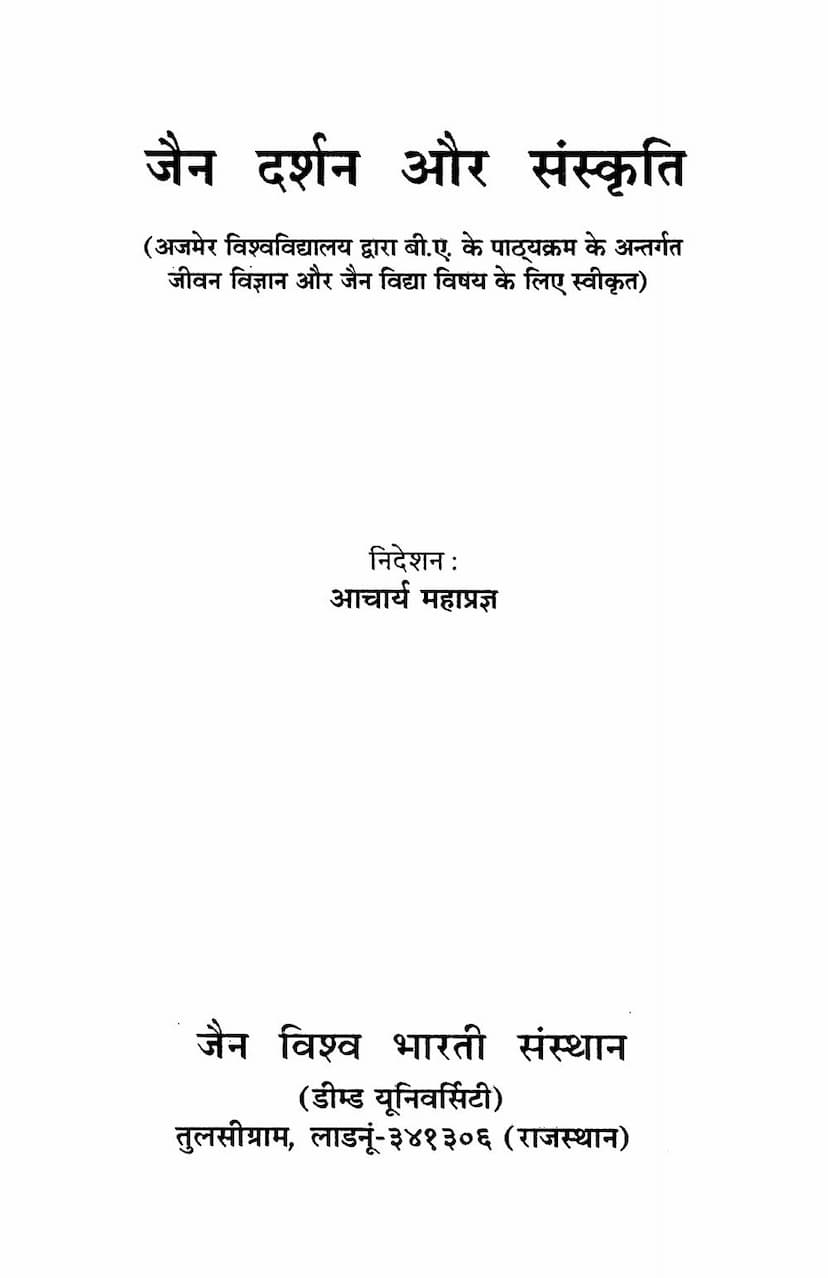Jain Darshan Aur Sanskriti
Added to library: September 1, 2025

Summary
The book "Jain Darshan Aur Sanskriti" by Acharya Mahapragna, published by Jain Vishva Bharati, offers a comprehensive introduction to Jain philosophy and culture. Approved as a part of the Bachelor of Arts curriculum at Ajmer University, the book aims to make the study of Jainism accessible and engaging for students.
The book is structured into three main sections: Philosophy, History, and Culture.
Section 1: Philosophy (Darshan)
This section delves into the fundamental principles of Jain philosophy, covering:
- The nature of Philosophy: It defines philosophy as a confluence of Truth, Goodness, and Beauty, exploring its definition, various approaches to value judgment (theoretical, practical, spiritual), and the distinction between intellectual reasoning and inner insight. It emphasizes that Indian philosophy, unlike Western philosophy, is intrinsically linked to spirituality and yogic practices.
- Cosmology: It explains the Jain understanding of the universe, classifying its components into six fundamental substances (dravyas): Dharma (medium of motion), Adharma (medium of rest), Akasha (space), Kala (time), Pudgala (matter/energy), and Jiva (soul/consciousness). It highlights that the first five, excluding time, are considered Astikayas (having extension or substance).
- Matter (Pudgala): It elaborates on the concept of Pudgala, its atomic nature (Parmanu), its qualities, and its manifestations in the material world like sound, touch, color, and smell. It also draws parallels between Jain physics and modern scientific concepts like conservation of matter and energy.
- The Universe: It discusses the origin and structure of the universe, rejecting creationist theories and explaining the Jain view of an eternal, cyclical universe. It also touches upon concepts of development and decline (vikas and hras).
- The Cycle of Birth and Death: It explains the Jain perspective on the cycle of rebirth, detailing the process of birth, the role of the soul (Jiva), and the journey through different life forms based on karma.
- The Nature of the Soul (Jiva): It explores the concept of the soul, its inherent qualities of infinite knowledge, perception, bliss, and power, and the philosophical arguments for its existence. It contrasts the Jain view of the soul with other Indian philosophical schools and discusses the relationship between the soul and the body.
- Karma and Self-Determination: It explains the Jain doctrine of Karma, how it binds the soul, and how individuals are the creators of their own destiny through their actions. It details the process of karma formation, its effects, and the path to liberation (Moksha) through karma-annihilation (Nirjara).
- Relativism (Syadvada) and the Logic of Standpoints (Nayavada): It introduces the core Jain epistemological principles of Syadvada (the doctrine of conditioned predication) and Nayavada (the theory of standpoints), which emphasize that truth is multifaceted and can be viewed from different perspectives. These concepts are presented as tools for achieving intellectual harmony and understanding diversity.
- The Synthesis of Faith and Reason: The book stresses the importance of both faith (Shraddha) derived from scriptures and reason (Yukti) in understanding the ultimate reality.
Section 2: History (Itihas)
This section traces the historical development of Jainism and its key figures:
- From Rishabha to Parshva: It covers the timeline of the early Tirthankaras, beginning with the first Tirthankara, Lord Rishabha, and progressing through the lineage to Lord Parshva, the 23rd Tirthankara. It discusses the social, economic, and cultural conditions of those eras, including the concept of Kulakaras (forefathers of humanity) and the evolution of governance and societal structures.
- Lord Mahavir and His Teachings: This extensive part details the life of the 24th Tirthankara, Lord Mahavir, from his birth, youth, renunciation, and ascetic practices to his enlightenment and the establishment of the Jain monastic order. It elaborates on his core teachings, emphasizing non-violence (Ahimsa), truthfulness (Satya), non-stealing (Acheya), celibacy (Brahmacharya), and non-possession (Aparigraha) as the five great vows. It also discusses the structure of the Jain Sangha (monastic community) and the importance of ethical conduct for both monks and lay followers.
- Later Traditions: It briefly touches upon the traditions that followed Lord Mahavir, mentioning key figures like Ganadhar Gautama and the development of different sects within Jainism.
- Jain Literature: It provides an overview of the vast Jain literary corpus, including the Agamas (sacred scriptures), their structure, their compilation, and the evolution of commentaries and post-Agamic literature in Prakrit and Sanskrit.
Section 3: Culture (Sanskriti)
This section explores the cultural impact and spread of Jainism:
- Foundational Principles of Jain Culture: It highlights the core values of Jain culture, such as renunciation (tyaga), asceticism (tapas), and the significant contributions to art forms like painting, calligraphy, sculpture, and architecture. It also mentions the importance of Jain festivals and observances.
- Spread of Jainism: It discusses the geographical expansion of Jainism across India and its influence in various regions. It also touches upon the international spread of Jain ideas and practices.
- Contribution of Jain Acharyas to Intellectual Development: This part emphasizes the role of Jain scholars and monks in advancing philosophical thought, ethics, and various other fields of knowledge. It showcases their contributions in areas like logic, metaphysics, ethics, and comparative religion.
Throughout the book, Acharya Mahapragna's guidance is evident, ensuring a clear, comprehensive, and scholarly presentation. The compilation and editing by Muni Mahendrakumar and Dr. Bhanwarlal Joshi have made the subject matter accessible to students. The book also aims to foster a harmonious understanding between materialism and spirituality, and between spirituality and science, by presenting a balanced perspective. The inclusion of comparative studies with other Indian philosophies and modern sciences enhances its academic value.
In essence, "Jain Darshan Aur Sanskriti" serves as an authoritative yet accessible guide to understanding the profound philosophical underpinnings, rich historical narrative, and vibrant cultural heritage of Jainism.